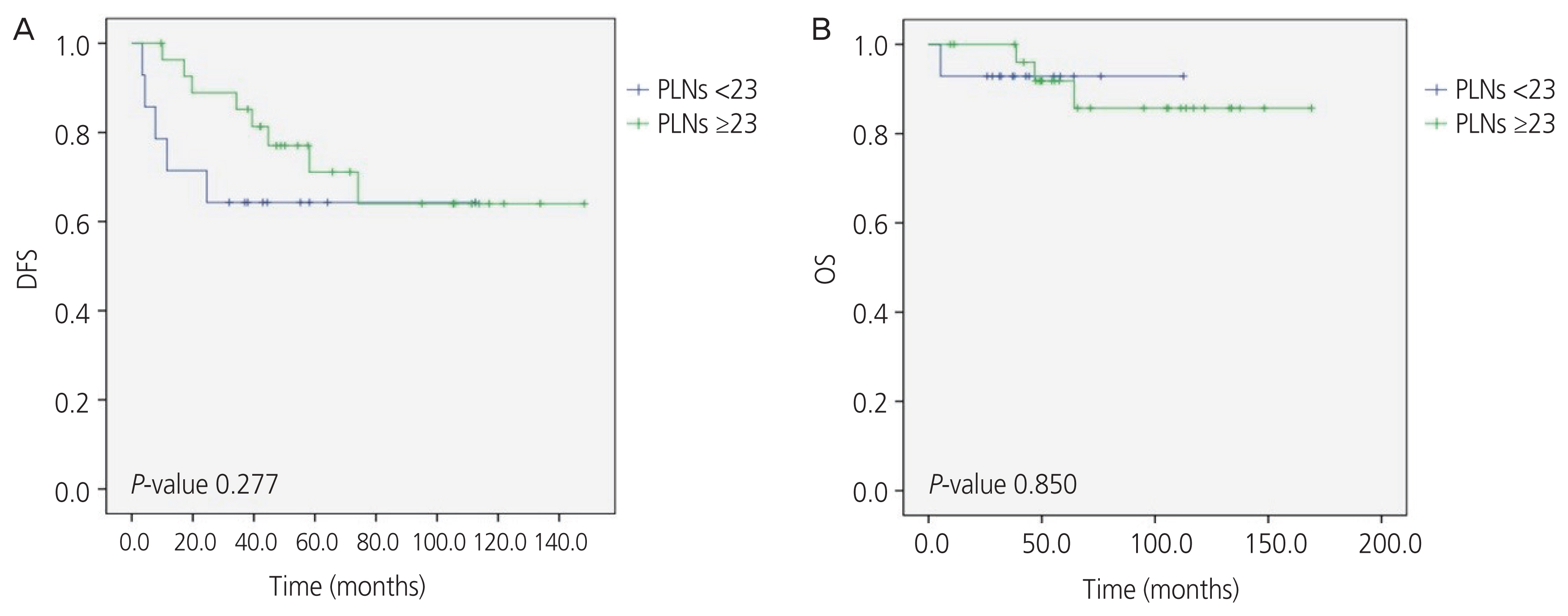Obstet Gynecol Sci.
2021 Jan;64(1):73-79. 10.5468/ogs.20016.
Clinical features that affect the number of pelvic lymph nodes harvested in patients with cervical cancer stage IB1 to IIA2
- Affiliations
-
- 1Department of Obstetrics and Gynecology, Seoul National University Bundang Hospital, Seongnam, Korea
- 2Department of Obstetrics and Gynecology, CHA Gangnam Medical Center, CHA University School of Medicine, Seoul, Korea
- KMID: 2511567
- DOI: http://doi.org/10.5468/ogs.20016
Abstract
Objective
To investigate clinical features that affect the number of pelvic lymph nodes (PLNs) harvested and prognostic significance of the number of PLNs removed in patients with stage IB1 to IIA2 cervical cancer.
Methods
Data from patients with cervical cancer whom underwent hysterectomy with PLN dissection between June 2004 and July 2015 were reviewed retrospectively. Data on clinicopathologic factors including age, height, and weight were collected. Data on the presence of PLN metastasis on imaging studies prior to surgery, number of PLNs harvested, and presence of metastasis in the harvested PLNs were retrieved from medical records. Clinical features associated with the number of PLNs harvested were analyzed. Disease-free survival (DFS) and overall survival (OS) according to the number of PLNs harvested were analyzed.
Results
During the study period, 210 patients were included. The height and weight of patients and preoperative positive positron emission tomography findings were significantly associated with a higher number of PLNs harvested. As a pathologic factor, larger tumor size was associated with a higher number of PLNs harvested. Furthermore, a higher number of PLNs harvested was associated with a higher number of metastatic PLNs and patients undergoing postoperative concurrent chemoradiation therapy. Patient height and tumor size were independent factors affecting the number of PLNs harvested in multivariate analysis. However, the number of PLNs harvested was not associated with DFS or OS.
Conclusion
The number of PLNs harvested during surgery was associated with patient height; however, this was not related to the prognosis of the disease.
Figure
Reference
-
References
1. Siegel RL, Miller KD, Jemal A. Cancer statistics, 2019. CA Cancer J Clin. 2019; 69:7–34.
Article2. Kweon SS. Updates on cancer epidemiology in Korea, 2018. Chonnam Med J. 2018; 54:90–100.
Article3. Delgado G, Bundy B, Zaino R, Sevin BU, Creasman WT, Major F. Prospective surgical-pathological study of disease-free interval in patients with stage IB squamous cell carcinoma of the cervix: a Gynecologic Oncology Group study. Gynecol Oncol. 1990; 38:352–7.
Article4. Bhatla N, Aoki D, Sharma DN, Sankaranarayanan R. Cancer of the cervix uteri. Int J Gynaecol Obstet. 2018; 143(Suppl 2):22–36.
Article5. Huang BX, Fang F. Progress in the study of lymph node metastasis in early-stage cervical cancer. Curr Med Sci. 2018; 38:567–74.
Article6. Lim S, Cho K, Lee S, Lee K, Shin J, Chung D, et al. Effect of number of retrieved lymph nodes on prognosis in FIGO stage IB-IIA cervical cancer patients treated with primary radical surgery. J Obstet Gynaecol Res. 2017; 43:211–9.
Article7. Peters WA 3rd, Liu PY, Barrett RJ 2nd, Stock RJ, Monk BJ, Berek JS, et al. Concurrent chemotherapy and pelvic radiation therapy compared with pelvic radiation therapy alone as adjuvant therapy after radical surgery in high-risk early-stage cancer of the cervix. J Clin Oncol. 2000; 18:1606–13.
Article8. Oaknin A, Rubio MJ, Redondo A, De Juan A, Cueva Bañuelos JF, Gil-Martin M, et al. SEOM guidelines for cervical cancer. Clin Transl Oncol. 2015; 17:1036–42.
Article9. Pieterse QD, Kenter GG, Gaarenstroom KN, Peters AA, Willems SM, Fleuren GJ, et al. The number of pelvic lymph nodes in the quality control and prognosis of radical hysterectomy for the treatment of cervical cancer. Eur J Surg Oncol. 2007; 33:216–21.
Article10. Shah M, Lewin SN, Deutsch I, Burke WM, Sun X, Herzog TJ, et al. Therapeutic role of lymphadenectomy for cervical cancer. Cancer. 2011; 117:310–7.
Article11. Ditto A, Martinelli F, Lo Vullo S, Reato C, Solima E, Carcangiu M, et al. The role of lymphadenectomy in cervical cancer patients: the significance of the number and the status of lymph nodes removed in 526 cases treated in a single institution. Ann Surg Oncol. 2013; 20:3948–54.
Article12. Aslan K, Meydanli MM, Oz M, Tohma YA, Haberal A, Ayhan A. The prognostic value of lymph node ratio in stage IIIC cervical cancer patients triaged to primary treatment by radical hysterectomy with systematic pelvic and para-aortic lymphadenectomy. J Gynecol Oncol. 2020; 31:e1.
Article
- Full Text Links
- Actions
-
Cited
- CITED
-
- Close
- Share
- Similar articles
-
- The outcome of the cervical cancer (stage Ib1) treated by radical surgery with and without neoadjuvant chemotherapy
- Prognostic factors of stage IB1 cervical cancer treated surgically
- Immunohistochemical analysis of pelvic lymph node micrometastases in cervical cancer patients with histologically negative nodes
- Factors associated with parametrial involvement in patients with stage IB1 cervical cancer: Who is suitable for less radical surgery?
- Laparoscopic Pelvic Lymph Node Dissection in Patients with Prostate Cancer: the Early Experience



